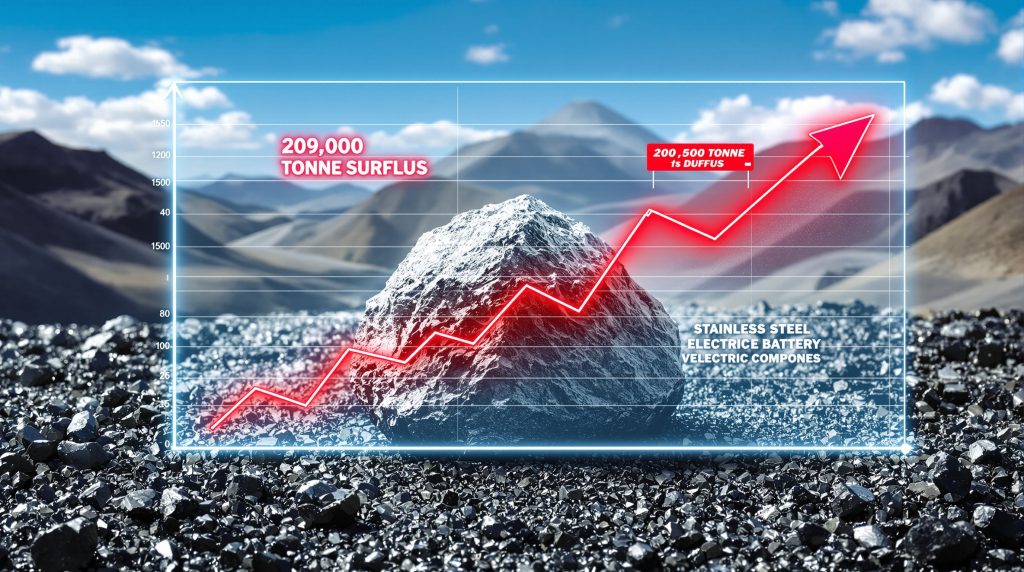How Did the Nickel Market Develop a Surplus?
The global nickel market has entered a significant transitional phase, with supply growth consistently outpacing demand in recent years. This fundamental imbalance stems primarily from aggressive production expansion, particularly in Indonesia, where government policies have actively encouraged downstream processing investments and value addition to raw materials.
Indonesian production capacity has expanded at a remarkable pace, creating a widening gap between global supply and consumption. According to the International Nickel Study Group (INSG) data, this production growth trajectory is expected to continue through at least 2026, further exacerbating market imbalances.
While demand for nickel continues to grow, particularly in stainless steel production and battery manufacturing, the rate of increase hasn't kept pace with the supply-side expansion. This growing disparity between production and consumption has established structural market conditions that industry analysts expect will persist through mid-decade, significantly impacting the battery metals investment landscape.
What's Driving the 209,000-Tonne Surplus Forecast for 2025?
The International Nickel Study Group (INSG) forecasts a substantial nickel market surplus of 209,000 metric tons for 2025, expanding further to 261,000 tons in 2026. This surplus represents approximately 5.5% of total market volume, creating significant implications for price stability and market dynamics.
Supply Growth Outpacing Demand
The fundamental driver behind this growing surplus is the significant imbalance between production growth and consumption. INSG data shows global nickel production is expected to reach 3.81 million tons in 2025, rising to 4.09 million tons in 2026—representing a robust production growth rate of approximately 7.3% year-over-year.
Meanwhile, global consumption is projected to reach 3.60 million tons in 2025, increasing to 3.82 million tons in 2026. This consumption growth rate of approximately 6.1% simply cannot keep pace with production expansion, resulting in the widening surplus.
Indonesia's Dominant Role
Indonesia remains the primary force driving global nickel supply growth, despite recent regulatory adjustments intended to exert greater control over the mining sector. These regulatory measures include:
- Delaying the issuance of mining permits (RKABs)
- Seizing lands that lack proper forestry permits
- Imposing sanctions on companies with missing reclamation and post-mining guarantees
Despite these regulatory tightening efforts, Indonesian nickel production continues its upward trajectory with minimal impact on overall output. The INSG reports that "the impact on nickel feed has been limited, and output is expected to continue rising in 2025 and 2026" as new projects continue to come online through mid-decade.
How Are Market Prices Responding to the Surplus?
The persistent and growing nickel surplus has placed significant downward pressure on market prices. After falling more than 7% in 2024, prices have struggled to gain meaningful momentum in 2025, showing only a modest 0.9% increase year-to-date as of October.
This price weakness directly reflects the market's fundamental imbalance between supply and demand. The continued buildup of warehouse inventories provides visible evidence of excess material in the market, further constraining price recovery potential.
Price Impact Factors
Various factors influence nickel price dynamics in the current surplus environment:
| Factor | Impact on Price | Outlook |
|---|---|---|
| Supply Surplus | Negative | Continuing through 2026 |
| Inventory Levels | Negative | Rising through 2025-2026 |
| EV Demand Growth | Slightly Positive | Below earlier forecasts |
| Stainless Steel Demand | Neutral to Positive | Steady growth expected |
| Regulatory Changes | Mixed | Limited impact on overall market balance |
Market analysts generally expect prices to remain under pressure until the surplus begins to dissipate, which appears unlikely before 2027 based on current production and consumption forecasts. This extended period of price weakness presents significant challenges for higher-cost producers and potentially impacts investment decisions for new projects.
Which End-Use Sectors Are Driving Nickel Demand?
Stainless Steel: The Traditional Demand Driver
The stainless steel industry remains the dominant consumer of nickel globally, accounting for approximately 70% of total demand. The sector's consistent growth has provided a solid foundation for nickel consumption for decades.
The INSG projects continued growth in stainless steel nickel demand through 2025 and 2026, though at a more moderate pace than seen in previous decades. Key factors influencing stainless steel demand include:
- Infrastructure development in emerging markets
- Construction sector activity and urbanization trends
- Consumer appliance and automotive manufacturing
- Increased recycling rates (potentially limiting primary nickel demand growth)
Regional variations in stainless steel production growth rates also impact nickel consumption patterns, with Asian markets—particularly China—continuing to lead global stainless output expansion.
Battery Sector: Growth Below Earlier Expectations
The battery sector, especially for electric vehicles, has been widely anticipated as the next major growth driver for nickel demand. However, actual consumption has fallen short of earlier projections for several reasons:
- Slower-than-expected electric vehicle adoption rates in key markets
- Increased use of lithium iron phosphate (LFP) batteries, which require no nickel
- Technical improvements reducing the amount of nickel needed per kilowatt-hour of battery capacity
- Economic headwinds affecting consumer purchasing power for premium electric vehicles
Despite these challenges, battery-related nickel demand continues to grow, albeit at a more modest pace than earlier forecasts suggested. The critical minerals energy transition sector remains strategically important for long-term nickel demand growth, particularly for high-purity Class 1 nickel products.
What Strategies Are Producers Adopting to Address the Surplus?
Nickel producers are implementing various strategies to navigate the challenging market environment created by persistent surplus conditions:
Production Discipline and Cost Management
Some producers, particularly those outside Indonesia with higher production costs, are demonstrating greater discipline by moderating output growth or delaying expansion projects. This approach aims to preserve capital during periods of weaker pricing and potentially accelerate market rebalancing.
Cost optimization has become a critical focus across the industry, with producers implementing efficiency improvements, energy-saving initiatives, and operational streamlining to remain competitive in a lower-price environment.
Product Differentiation and Value Addition
Forward-thinking producers are increasingly targeting higher-value nickel products that command premium prices, particularly battery-grade materials that meet stringent quality specifications for the EV supply chain.
Market segmentation strategies recognize the growing differentiation between:
- Class 1 nickel (≥99.8% purity): Suitable for batteries and specialized applications
- Class 2 nickel (<99.8% purity): Primarily used in stainless steel production
Some producers are pursuing vertical integration opportunities, moving downstream into battery precursor or cathode active material production to capture additional value and secure offtake arrangements with battery manufacturers.
How Might the Surplus Affect Investment in New Projects?
The projected multi-year nickel market surplus 2025 is already influencing investment decisions for new nickel projects globally, with both financial and strategic considerations at play.
Project Development Challenges
The surplus environment creates several challenges for new project development:
- Financing Constraints: Lower price expectations make it more difficult to secure financing for new projects, particularly for junior mining investment strategies.
- Higher Hurdle Rates: Investors increasingly demand higher projected returns to compensate for market risks in an oversupplied environment.
- Focus on Low-Cost Assets: Projects with first-quartile operating costs receive priority, while higher-cost developments face delays or cancellation.
- Strategic Considerations: Some projects may advance despite challenging market conditions if they serve strategic supply chain objectives, particularly for battery-grade materials.
Regional Investment Patterns
The surplus impact on investment varies significantly by region:
| Region | Investment Outlook | Key Drivers |
|---|---|---|
| Indonesia | Continuing but moderating | Government support, integrated processing advantages |
| Australia | Selective development | Focus on battery-grade nickel, established mining framework |
| Canada | Strategic investments | Supply chain security, ESG advantages |
| Africa | Limited near-term growth | Higher perceived risk in surplus market |
| Russia | Steady but constrained | Geopolitical considerations affecting investment |
Projects with strong ESG credentials, particularly those with lower carbon footprints or responsible water management, may attract preferential investment despite market challenges as automotive and battery manufacturers increasingly prioritize sustainability in their supply chains.
What Are the Long-Term Market Balance Projections?
Looking beyond the current surplus period, the nickel market is expected to gradually move toward balance as several factors converge:
-
Supply Growth Moderation: The current wave of Indonesian expansion projects will eventually reach completion, with fewer new projects entering the pipeline due to current price constraints.
-
Demand Acceleration: Battery sector consumption is projected to increase substantially in the latter part of the decade as EV adoption rates rise globally and battery manufacturing capacity expands.
-
Project Delays and Cancellations: The current surplus environment is already leading to delays or cancellations of planned projects, which will limit future supply growth and potentially accelerate rebalancing.
-
Policy Impacts: Government policies promoting domestic battery manufacturing and electric vehicle adoption may stimulate additional nickel demand beyond current projections.
Most industry analysts project that the market will remain in surplus through at least 2027, with a potential return to balance or even deficit conditions in the 2028-2030 timeframe. According to the nickel market forecast from Investing News Network, this outlook depends significantly on the pace of electric vehicle adoption and the evolution of battery chemistry preferences, both of which involve considerable forecast uncertainty.
How Does the Surplus Impact Different Types of Nickel Products?
The market surplus affects various nickel product categories differently, creating distinct market dynamics and price impacts across the product spectrum.
Class 1 Nickel (≥99.8% Purity)
High-purity Class 1 nickel, which includes cathode, briquettes, powder, and certain other forms, maintains strategic importance for battery applications and other specialty uses requiring high purity. Key characteristics of this market segment include:
- Premium pricing compared to Class 2 products
- Less pronounced surplus than in the broader market
- Strategic importance for battery supply chains
- Higher barriers to entry for new production
Despite the overall market surplus, certain Class 1 products specifically suited for battery applications maintain relatively stronger market fundamentals, particularly as automotive manufacturers secure long-term supply agreements.
Class 2 Nickel (<99.8% Purity)
Lower-purity Class 2 nickel, primarily used in stainless steel production, bears the brunt of the market surplus impact. This category includes nickel pig iron (NPI), ferronickel, and various nickel oxide products. Market dynamics include:
- More severely impacted by overall market surplus
- Dominated by Indonesian production growth
- Greater price pressure than Class 1 products
- Higher sensitivity to stainless steel industry conditions
Indonesian nickel pig iron (NPI) production growth has been the primary driver of the global surplus, with significant capacity additions continuing through at least 2026 according to INSG projections.
Nickel Sulfate and Battery Materials
Specialized battery materials, particularly nickel sulfate, occupy a distinct market position with unique dynamics:
- Growing demand despite overall market surplus
- Premium pricing over LME nickel
- Specialized production capacity limiting oversupply
- Quality specifications creating market segmentation
The technical requirements for battery-grade materials create a natural segmentation within the nickel market, with automotive and battery manufacturers willing to pay premiums for materials that meet stringent specifications for consistency, purity, and sustainability.
What Are the Environmental and Sustainability Implications?
The nickel market surplus has several important environmental and sustainability implications that will influence mining industry evolution and investment patterns:
Production Methods and Environmental Impact
The competitive pressure created by surplus conditions may incentivize producers to prioritize cost reduction over environmental performance, potentially increasing the sector's overall carbon footprint. However, this trend faces counterbalance from growing customer demand for responsibly produced materials.
High-pressure acid leach (HPAL) processing, a key technology for producing battery-grade nickel from laterite ores, presents significant environmental challenges despite its importance for the EV supply chain. These include high energy requirements, waste management issues, and potential acid contamination risks.
ESG Differentiation in a Surplus Market
Despite overall surplus conditions, nickel produced with demonstrably lower environmental impacts increasingly commands premium pricing as battery and automotive manufacturers prioritize sustainable supply chains to meet their own corporate commitments and regulatory requirements.
This trend creates potential competitive advantages for producers with:
- Lower carbon intensity per ton of nickel produced
- Responsible water management practices
- Strong community relationships and social performance
- Transparent ESG reporting and third-party verification
Recycling Economics and Circular Economy Initiatives
Lower primary nickel prices challenge the economic viability of recycling operations, potentially slowing the development of circular economy initiatives. This economic pressure comes at precisely the time when establishing robust recycling infrastructure for battery materials is becoming increasingly important.
Policy interventions, such as extended producer responsibility requirements and recycled content mandates, may become necessary to support recycling economics in a surplus environment where primary material prices remain under pressure.
Navigating the Nickel Market Through 2026
The nickel market is experiencing a period of structural oversupply that will likely persist through at least 2026. This surplus, forecast at 209,000 tons in 2025 and expanding to 261,000 tons in 2026, continues to shape market dynamics, pricing trends, and investment decisions across the value chain.
Indonesia's production growth remains the primary driver of the surplus, with INSG data confirming output will continue rising despite recent regulatory measures. On the demand side, factors including the pace of EV adoption and battery chemistry choices will determine how quickly the market returns to balance.
For producers, the surplus environment demands strategic responses including cost optimization, product differentiation, and selective investment in high-quality assets. Consumers benefit from lower input costs in the near term but face potential longer-term supply security risks if persistent low prices discourage necessary investment.
Investors must carefully evaluate nickel projects with a nuanced understanding of product specifications, cost position, and strategic importance. While the overall market remains oversupplied, opportunities exist in specific product categories and for projects with exceptional cost positions or ESG credentials, such as the Tamarack Nickel-Copper Project.
Understanding the complexities of different nickel products, end-use sectors, and regional market dynamics will be crucial for all market participants navigating this challenging environment while positioning for the eventual market rebalancing expected in the latter part of the decade.
Want to Stay Ahead of Major Nickel Market Movements?
Discovery Alert's proprietary Discovery IQ model provides instant notifications on significant ASX mineral discoveries, including nickel, copper and battery metals opportunities. Explore why mineral discoveries can lead to substantial returns by visiting our dedicated discoveries page.




